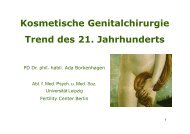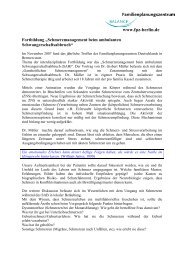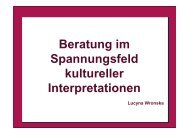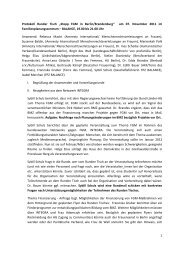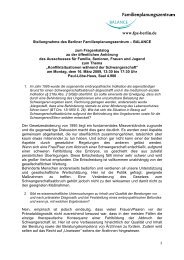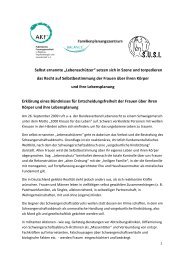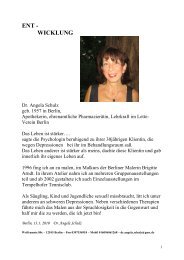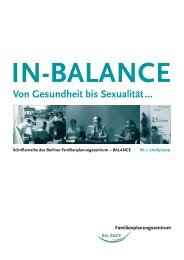Listening to African Voices - FPZ
Listening to African Voices - FPZ
Listening to African Voices - FPZ
You also want an ePaper? Increase the reach of your titles
YUMPU automatically turns print PDFs into web optimized ePapers that Google loves.
FGM/C and none of the parents expressed the intention <strong>to</strong>subject them <strong>to</strong> the practice in the future.5.5.7.4. Perceptions related <strong>to</strong> the practiceAll participants were somehow familiar with FGM/C. Thegreater part of the participants, 31 out of 55 felt that it wasa practice without advantages:“It should s<strong>to</strong>p. I learnt about it in the media and throughWaris Dirie’s book. I wonder why educated womencontinue <strong>to</strong> circumcise their daughters. We are in the 21stcentury and I see absolutely no need for such negativetraditions <strong>to</strong> be practiced.” (woman from a non-practicinggroup in Kenya)“I find it <strong>to</strong> be so bad. It’s not a good practice”. (womanfrom a practicing family in Kenya)For the remaining participants, FGM/C incorporates certainpositive aspects. The most frequently raised advantageswere linked <strong>to</strong> the faithful and decent behaviour of the girlsand women on which the family honour depended. Somewomen participants concluded that the decrease of FGM/Chas also lead <strong>to</strong> a loss of values and indecent behaviour ofwomen.“In the old days when I was young, sex was only used forpro-creation and not for enjoyment. The older womenwho are circumcised are well behaved and reservedcompared with the younger generation. Female circumcisionreduces prostitution because the woman doesn’tfl irt. Women are faithful <strong>to</strong> their husbands. Circumcisedwomen dress decently and they don’t provoke men theway the uncircumcised women do.” (woman of Kenyanorigin)5.5.7.5. FGM/C and religionMost participants of Kenyan origin do not perceive FGM/Cas a religious practice. Only two participants, a Christianwoman and a Muslim man from practicing families, statedthat FGM/C was a religious requirement for them.5.5.7.6. Perception of disadvantages and knowledge of risksand consequencesThe level of awareness of the risks and negative consequencesof FGM/C was high in the sample interviewed: about 83%of the participants mentioned at least one negative outcomeor risk. Particularly frequent effects named were pain, infectionsand an impaired sexual life for the women. There wereno notable differences in the degree of awareness betweenmen and women.“I feel sorry for the affected ladies. I can imagine thattheir sexual lives are ruined and many of them never hada say in it. I want <strong>to</strong> see it s<strong>to</strong>pped. My sister is lucky thatshe grew up in Germany. Otherwise she would have beenin the same group. I believe that it is very strong on mygrandmother’s side, but since my mother came here along time ago, I don’t think that she would have allowedit.” (young man of Kenyan origin)5.5.7.7. Knowledge of German law and attitudes <strong>to</strong>wards theabandonment of FGM/CMost participants knew that FGM/C was not allowed inGermany (71%). One participant responded that FGM/Cwas not explicitly mentioned in German legislation and 15participants were unsure about the position of the Germanlaw <strong>to</strong>wards FGM/C. There were no differences in the levelof knowledge of men and women.The majority of participants reported <strong>to</strong> be in favour ofabolishing the practice. Out of the <strong>to</strong>tal sample of 55 participants,only one man did not support the abolition of thepractice. One possible explanation for the attitudes againstFGM/C might be the relatively high education level of theKenyan immigrants. As mentioned above, all interviewedparticipants have attained at least a secondary schooleducation.5.5.8. Benin5.5.8.1. Socio-demographic profileBenin’s (registered) immigrant community consists of 219persons with men more than twice as numerous (151) aswomen (68).We did not reach many members of the Beninese communityduring the first month of data collection. In thesecond phase of data collection, the team was joined by tworesearchers of Beninese origin, one man and one woman,and they managed <strong>to</strong> reach out <strong>to</strong> a significant number ofimmigrants: 31 women and 68 men adding up <strong>to</strong> a <strong>to</strong>talsample of 99 participants.The researchers described a strong desegregation of immigrantsfrom southern and northern regions of Benin. The immigrantsfrom the northern region have their own immigrantassociation (association de Djougou) and don’t open upeasily <strong>to</strong> people from other areas. The two researchers camefrom the southern and central region respectively, and theyreported limited success in reaching the community fromnorthern Benin. According <strong>to</strong> their impressions, the peoplefrom the South are overrepresented in the sample. Severalkey informants <strong>to</strong>ld them that immigrants from the northern<strong>Listening</strong> <strong>to</strong> <strong>African</strong> <strong>Voices</strong> 63





